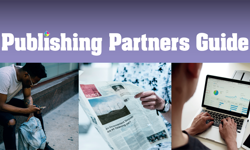It’s good that the work of circulation professionals has become more precise, even scientific, as the decades pass. But it does concern me that new entrants arrive in the profession thinking all problems can be solved by numbers and all solutions can be produced on a calculator.
When experts like Peter Hobday bang the drum for testing, I totally agree, but worry that lesser talents think the test is everything. I’m sure he’d agree that to break free from the pack you have to have something before the test. And that’s the big or the new or the innovative idea.
And ideas are where the small guys can punch well above their weight against the big firms and their number crunchers. Think about it. The reason why innovations for big titles often come from the bright ideas and lateral tap-dancing of the smaller guys is simple. You are trying to raise margins for your employer; they are in a life or death struggle to survive and feed their families.
And when those kind of pressures are on you, believe me, you think fast and laterally.
For example? Here’s a random selection of my favourite ideas. Feel free to adapt them to your work as you will. There’s no copyright on ideas, only execution.
Small is good
Never – ever – look down on small family run operations like newsletters with their two-colour, no photos, ‘mom & pop’ folksiness. What they lack in gloss, they more than make up for in profitability. Profit margins over 50% are common.
Consider the business model of a newsletter. A subscription publication is the total reversal of other forms of publishing. With these, your readers pay you first, then you pay your printer and the Royal Mail. No returns, no warehouses full of unsold magazines, no 50% rake-off to the wholesalers.
Everything to do with them is simple: the speed of creation, the simple process of setting out your stall and asking people to buy, the control you have of your life and your time, the non-reliance on the shifting sands of ad sales or WH Smith's capricious decisions on what they put on their shelves.
Because they are high priced, they are hit harder than the big-timers when a subscription cancels. As a result, they love their subscribers to pieces. In many cases, they actually know them.
Since they have that kind of pressure, they do little else but look for ideas and try them.
Don’t hang about
One day a cartoonist's light bulb went on above my head. People need information about how to get their hands on grants from the National Lottery. Eight weeks later the first issue of Lottery Monitor was out. That’s all the time it took to polish the idea, research the options, create the sales copy, mail potential subscribers, bank a few cheques, write the articles and post out the first issue. Four years after that I had sold it for a million pounds. Forget Mini Me. This is the way to become a Mini Murdoch.
Spend all your income at once
Ok, that’s deliberately provocative. But a startup publication is an all-consuming activity, certainly for the first year. So forget living off the profits. Take your salary and put the rest back into building sales. All revenue has to be used to keep recruiting more subscribers. No subscription business ever has 100% renewals. The metaphor is a pipeline which begins leaking exactly one year after you sold your first subscription. You have to keep putting new readers in at one end as departures leave at the other.
You know how to plan the marketing of your title once you know your renewal rate and the success rates of your – well tested – renewal mailers. But in the first year you’re relying on work and luck. And the harder you work and the more you spend on sales, the luckier you’re likely to be.
Editorial comes first
Yes, as an ex-hack, I would say that, wouldn’t I? But ignore the content of what you are marketing at your peril. You have my sympathies if the editorial side aren’t welcoming to your input, but if they are like that, try to win them over. It's the editorial that makes subscribers come back for more. Not the colour, not the paper, not even the price.
They will gladly pay for another year's supply of information if the content made their lives more easy or efficient or secure or professional. Those are the promises you have made, rightly, in your marketing. If the journalists don’t deliver on your promises, they will be looking for work soon. Sadly, so will you.
Flagships make reputations, ancillaries make profits
My flagship was Lottery Monitor. It looked like a newsletter but it was actually a small industry involving a second spin-off newsletter, an annual readers' conference, a Scottish conference and research reports. Electric Word bought it because of the potential for even more profits from all those ancillary activities. They run many lottery conferences each year and sell more reports than even I had thought of.
The circulation benefits of ancillaries are huge. Subscribe to the newsletter and get lower conference rates; attend the conference and get a discount on a special report, order three reports and get a discount on the newsletter subscription. And so on, a circular heaven.
There’s always a subscriber
There’s not enough space here but the page I enjoyed creating most on my newsletter masterclass website was "Who Should Attend". This is just a fraction of the real titles that people (mainly Americans) are happily forking out hard cash for:
F.O. Licht's World Tea Markets Monthly, Bert Dohmen's Fearless Fund & Index Trader, Arrest Law Bulletin, Waste Week, Topics in Pain Management, Transporting Students with Disabilities, School Discipline Advisor, School Violence Alert, Legal Briefs for Fire Chiefs, Cabin Crew Safety, International Wealth Success, The NEWSLETTER Newsletter, Newsletter on Newsletters, Effective Telephone Techniques,…
And there's thousands more than that. Enter "newsletter" in Google and what do you get? 69,500,000 hits! Go sell.
There’s no list like your own list
Don’t get into a mindset that says – buy a list and sell to it. Inevitably, the time will come when there is no list that fits absolutely to your needs. The foolish will conclude they have found evidence there's no demand for the title. Nonsense. What you have discovered is great news. You have established that nobody else has thought of selling to this market.
So roll up your sleeves and get to work. Google will produce names from websites on the topic. Trade associations that won’t sell lists will take inserts in their members’ newsletters. Current readers will be glad to suggest names – just ask them. Try American list sellers; their lists are so large they might have a few hundred UK subscribers who, until now, have been forced to seek this information abroad.
Harder work than buying a list but worth it when you consider how much wastage an old purchased list will contain. Your lists will be super-filtered as you go along.
Overdeliver
This is obvious but always benefits from saying out loud every morning. When renewal time comes around the first to disappear will be those who think they got less then they expected. The Yanks, as ever, have a phrase for it: "the extra mile will have no traffic jams." Another is "performance will outsell promises."
If the fulfilment house is delivering the newsletters late, it’s your department they’re hurting. Give ‘em hell. If you send speakers’ notes to those who attended one of your conferences, send them six months later as an unexpected thank you to those who didn’t come but are about to decide on renewing.
Miscellaneous thoughts
* A business-to-business newsletter can be priced as high as the subscribers will pay. Sure, but how do you know in advance? There’s no answer to this but make sure it’s high and not low. My favourite price was £260 a year since the 25% discount opening offer brought it down to £195, i.e. less than £200. However you can play around with figures and discount rates higher up the scale to get the same apparent ‘saving.’
* Give free newsletters to conference organisers to 'thicken' their delegate bags. There’s no cost to you (use slightly recent overs) and you reach people within the quality image of the event - check that out first, of course!
* Plaster your web address all over your paperwork, invoices, renewal notes, letterhead, order forms, everything.
* Even if you’re not in the newsletter business, check out their trade organisation UKNEPA (www.newsletters.org). Their members’ website and bulletins bristle with money-making and innovative thoughts on circulation building.
And that’s where I came in.
FEATURE
Ideas before testing
He publishes glossy mags with luxury advertising, yet Alasdair Buchan retains his membership of the organisation for newsletter publishers. It’s because, in publishing, you never know where your next bright idea for building circulation or profits will come from.










